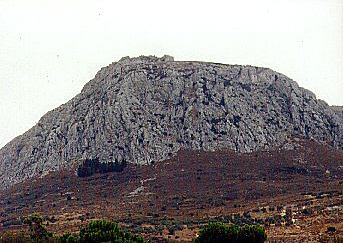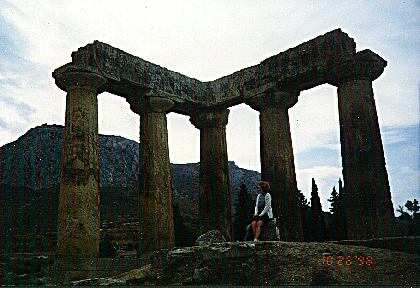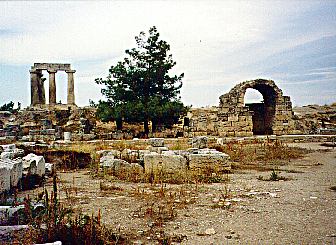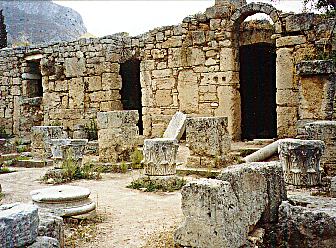 To Map
To Map
Corinth
A Brief HistoryWhen Paul arrived in 51 CE, the Corinth he saw was little more than 100 years old, but was five times as large as Athens and the capital of the province. Ancient Corinth, the original Corinth, founded in the 10th Century BCE, had been the richest port and the largest city in ancient Greece. Strategically located guarding the narrow isthmus that connects the Peloponnesus (as southern Greece is called) to the mainland, it was a powerful commercial center near two seaports only 4 miles apart. Lechaeum, the western harbor in the Corinthian Gulf was the trading port to Italy and Sicily, and Cenchreae, the eastern harbor in the Saronic Gulf, was the port for the eastern Mediterranean countries. Periander (ca. 625-585 BCE) had constructed a five foot wide rock-cut tract (Gk. diolkos) for wheeling small ships and their unloaded cargo from one gulf to the other. By 400 BCE, a double wall ran from the city to Lechaeum to protect a two mile rock paved street, about 40' wide, leading to the port.
| When Rome demanded the dissolution of the Achaian League, Corinth, the leader, resisted and so Lucius Mummius, the Roman consul, leveled the city in 146 BCE, killed the men and sold the women and children into slavery. Some of the wealthier families escaped to the island of Delos. For the next 100 years, only a handful of squatters occupied the site. Julius Caesar refounded the city as a colony in 44 BCE, named it Colonia Laus Julia Corinthiensis and populated it with conscripted Italian, Greek, Syrian, Egyptian and Judean freed slaves. New Corinth, as Ancient Corinth, thrived. "Within just a few years, new Corinth's settlers' enormously profitable commerce at this crossroads of the nations had brought thousands more eager settlers from all over the Mediterranean and enormous personal wealth to a local ruling class of self-made women and men." [Horsley and Silberman, The Message and the Kingdom,p. 163] The wealthy Greek families who had fled to Delos also returned. | 
Roman imperial ruins: the spring of Peirene. The
arched
openings led to bowls carved in the rock
where water collected. |
 | Commentators usually assume that Corinth was an especially licentious city, a reputation it seems to have had in ancient times. Indeed, one of the Greek verbs for fornicate was korinthiazomai,a word derived from the city's name. Apparently this estimation was based on Strabo's report of 1,000 sacred prostitutes in the temple of Aphrodite on the Acrocorinth, an 1886-foot hill that rises above the city to the south. Recent scholars point out, however, that the charge was more likely an Athenian slander against the pre-146 BCE city since sacred prostitution was a Middle East custom, not a Greek one. No doubt Corinth, like other large port cities, had plenty of prostitutes to service the sailors, but they were not sacred.
The Acrocorinth, the acropolis of the ancient city, was heavily fortified during the Middle Ages. Nothing is left of the fabled temple to Aphrodite, but remains of the medieval fortifications, which were built on earlier foundations, may still be seen from the western side. |
Paul Settles DownIt's easy to see why Paul chose Corinth as headquarters for his mission to the west. The city was young, dynamic, not hidebound by tradition, a mix of dislocated individuals without strong ethnic identities seeking to shed their former low status by achieving social honor and material success. Paul was not intimidated by a big, bustling, cosmopolitan hub city, with no dominant religious or intellectual tradition, for Corinth shared many characteristics with Tarsus, his home town, and Syrian Antioch, his home church city. The heart of the city, the forum, was filled with temples and shrines to the emperor and various members of his family, built alongside temples to the older Greek gods such as Apollo. Apollo's son, Asklepios, the god of healing, had a shrine there as well as at Epidaurus, the ancient site of miracle healings, about 50 miles southeast.
Little remains of the ancient city of Corinth. These ruined arches and entryways to shops on what was once the agora call on the tourist's imagination to see the gleaming buildings, complete with statuary, they once were.Luke's account of Paul's stay in Corinth is found in Acts 18:1-18. According to the story, after some initial success in the synagogue, but with considerable conflict, he decides to concentrate on the non-Jews, apparently with significant success. He settles in and stays for 18 months, working as a tentmaker and living with fellow tentmakers, Aquila and his wife Pricilla (Prisca in his letters), two of the Jews expelled from Rome by Emperor Claudius in a general expulsion. His success may have led to his being dragged before Gallio, the Roman proconsul, by the local Jews for heresy. Gallio dismisses the charge as a purely intra-Jewish affair. Soon afterwards Paul leaves, accompanied by Aquila and Pricilla, bound for Antioch, but on the way they stop over in Ephesus.
We Visit the Ruins
 | On the way to ancient Corinth from Athens, our bus stopped at the Corinth Canal which had been cut through the isthmus since Paul crossed over. Even Periander had envisioned the canal, but lacking the technology, he settled for the marble tramway. At the time, it was also thought that Poseidon, god of the sea, opposed joining the Aegean and the Adriatic. Others dreamed of constructing the canal, including Julius Caesar, because it saved 200 miles of sailing around the Peloponnesus, but it was Nero who actually attempted it in 66 CE. Included in his workforce were 6,000 young Jewish slaves recently captured by Vespasian in Galilee, where the Jewish war had begun. His attempt was soon abandoned on the belief that if the seas where connected, the more northerly Adriatic, mistakenly thought to be higher, would flood the more southern Aegean. A French company, which began the work in 1881 where Nero's crew had stopped, completed the canal in 1893. What finally killed ancient Corinth was the earthquakes, but it has been extensively excavated. The museum contains many intriguing artifacts found there, e.g., a room of items used in healing ceremonies and a room of sculptures, including the beautiful Corinth sphinx and a portrait of the young Nero. It was quite interesting, but seemed a bit run down compared to the museum at Delphi. Outside, one sees acres of building and pavement stones, the arrangement of which make sense only after looking at a map of the area. We saw the well known synagogue lintel inscription, but learned later that it cannot be dated precisely. On one edge of the forum or agora was the famous "Bema" on which the Roman proconsul would hold court and where "Pastor Bob" read the account of Paul's appearance before Gallio (Acts 18:12-15). |
 That the Emperor cult, the indigenous Greek religion of the mythological gods, Eastern religions like Mithranism, and the mystery cults formed the religious background of Paul's mission was no less true in Corinth, perhaps more so, than other places he went. Paul dismissed his competition as mere idols or images and to some extent prevailed as he attracted adherents to his "kingless kingdom." All that remains visible in Corinth today of the religio-political structure Paul confronted are a few columns of the temple of Apollo. Where better to contemplate the glories of a by-gone age and what might have been celebrated on the Acrocorinth long ago.
That the Emperor cult, the indigenous Greek religion of the mythological gods, Eastern religions like Mithranism, and the mystery cults formed the religious background of Paul's mission was no less true in Corinth, perhaps more so, than other places he went. Paul dismissed his competition as mere idols or images and to some extent prevailed as he attracted adherents to his "kingless kingdom." All that remains visible in Corinth today of the religio-political structure Paul confronted are a few columns of the temple of Apollo. Where better to contemplate the glories of a by-gone age and what might have been celebrated on the Acrocorinth long ago.
To Ephesus 





